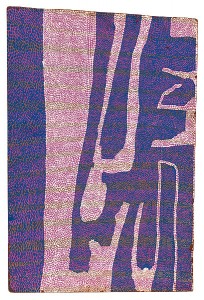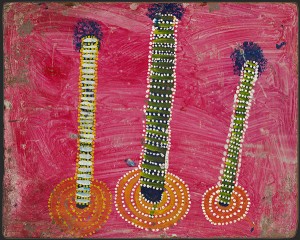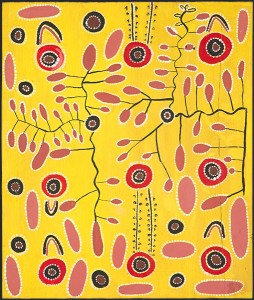Small giants
The earliest paintings of the Western Desert art movement sparked a shift that would become a game-changer for Aboriginal art in Australia. Their appearance in the early 1970s prompted a re-evaluation of existing art world discourse; the Papunya boards, as they became known, made a convincing case for their reception as contemporary art, rather than ethnography. This shift opened the door for the many regional movements and artists that form a broad picture of Indigenous art today.
The fact that the paintings surveyed in Tjukurrtjanu represent such a watershed moment in the history of Australian art can initially be hard to imagine. They are, for the most part, strikingly humble when compared to the vast canvases which would come after them. But the scavenged offcuts of board and chalky student-grade poster paint the artists used manage to add up to far more than the sum of these parts, revealing countless possible directions for a then fledgling art movement.
Tjukurrtjanu brings the individual achievements of the founding artists—a small group of traditional senior men who came together in the tiny community of Papunya—into sharp relief. Walls displaying an artist’s approach to specific themes, and more generally to a new medium, frame engaging moments of studio-based invention. An example of this lies in Timmy Payungka Tjapangati’s 1972 work, Sandhill country west of Wilkinkarra, Lake Mackay, where underpainted bands of hot pink and ochre yellow, all but obscured by a densely dotted overlay, add an almost imperceptible shimmer to the work’s surface. This succinct visual effect, achieved with so little, makes the innovation of the boards in general clear—they arrived at a time, and within a context, where anything was possible and the appearance of Western Desert art was essentially undefined. Despite having been painted some forty years ago, many of the boards still stand among the best of Western Desert art. Put simply: there’s nothing like them.
Tjukurrtjanu: origins of Western Desert art, Ian Potter Centre: NGV Australia, Melbourne, 30 September 2011 – 12 February 2012.


